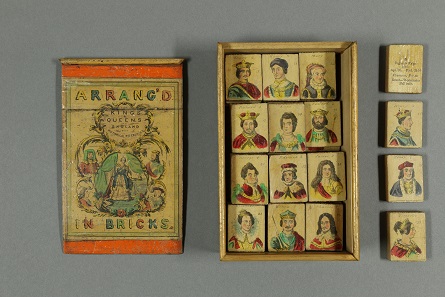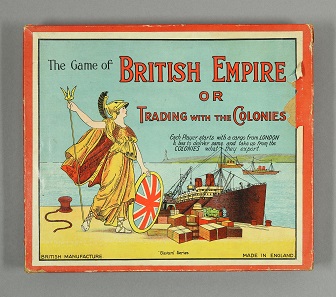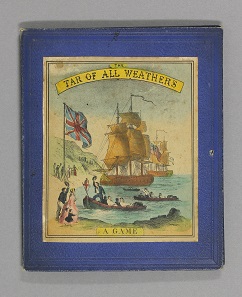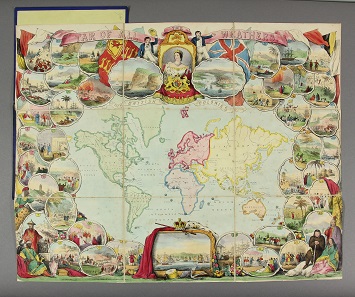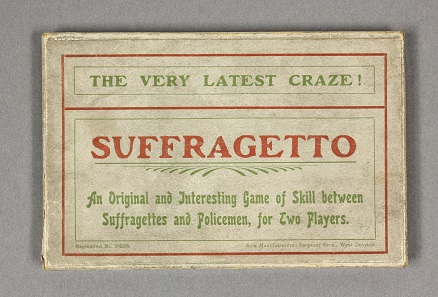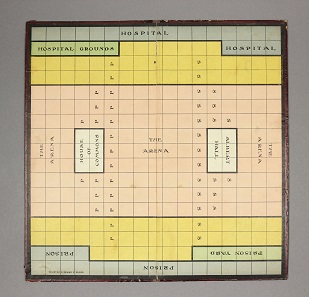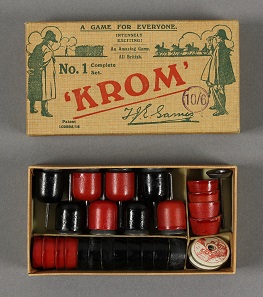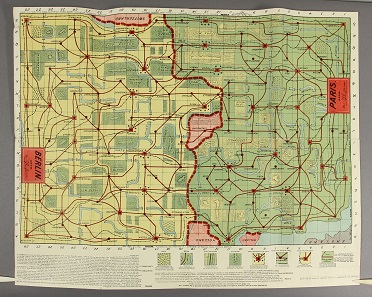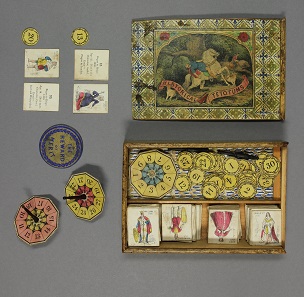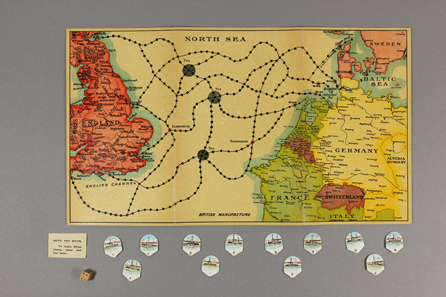February 18, 2016 – The Bodleian Libraries has recently acquired a major collection of board games and pastimes dating from 1800 to the year 2000 and is showcasing a selection of them in a new display exploring how games have been used to teach history. ‘Playing with History’ is currently on exhibition in the Weston Library and features 22 games that show how children in Victorian and Edwardian Britain learned about the world around them.
Arrang’d in bricks. The Kings & Queens of England with historical references. [British, maker unknown, c. 1840]. A wooden box with illustrated label on the sliding lid. The 36 blocks, numbered chronologically, represent British monarchs from William I to Queen Victoria. © Bodleian Libraries, University of Oxford.
Nearly 1500 board games donated
The games selected for the display represent a tiny slice of the rich and varied collection of almost 1500 board games and pastimes that collector Richard Ballam recently donated to the Libraries.
‘Playing with History’ focuses specifically on how games were used to teach children about three topics: kings and queens, the British world view and war and conflict in the early 20th-century.
The new game of British Empire or Trading with the Colonies. Roberts ‘Glevum’ series [c. 1925]. Folded board (damaged), teetotum, dice, 3 metal ships, small sheets (to be cut up) listing British exports, small cards listing colonial exports with their country of origin. © Bodleian Libraries, University of Oxford.
Games from 1800 to 1925
Visitors can see a fascinating range of games and teaching aids dating from 1800 to 1925 including card games, wooden blocks, dissected puzzles (a precursor to the jigsaw), glass-topped puzzles, strategy games and board games played with a spinning top called a teetotum.
Games as mirror to society
‘Games are fascinating because they hold a mirror to society,’ said the display’s curator Julie Anne Lambert, Librarian of the John Johnson Collection at the Bodleian Libraries. ‘Games which aim to teach history are particularly interesting as it is impossible to take an unbiased view of the past or the present, so the images, text and format of the games reveal much about the attitudes and perspectives that were prevalent at the time.’
The Tar of all weathers; or, The British Colonies. A geographical game. London, E. and M.A. Ogilvy (publishers), Samuel Straker (printer and lithographer). Board signed J.R. Barfoot, [c. 1857]. Hand-coloured lithographed pictorial sheet, mounted on linen, folded into 9 sections and bound. © Bodleian Libraries, University of Oxford.
Game of Empire
The display features games that are rich in symbolism, such as Tar of All Weathers, a game of empire which shows Queen Victoria resplendent at the head of her colonies in Africa and Asia. The 16-page accompanying booklet to this game has an instructive paragraph on each of 39 colonies. There are two different Directions for Playing, the second being an easier version. The game is lacking the card from which the names of colonies had to be cut up. In the full version, the participants had to match these names to their geographical location and to the images surrounding the map.
Suffragetto Board, with box containing rules and 42 pieces (complete). [Sargeant Bros, c. 1917]. © Bodleian Libraries, University of Oxford.
Great War and suffragettes – big conflicts, big games
The conflict section of the display includes games such as Suffragetto, which describes itself as ‘an original and interesting game of skill between suffragettes and policemen.’ The object of the game is for each player to get six of his pieces into the square representing the building (House of Commons or Albert Hall) defended by his opponent. The suffragettes have 16 small green pieces with 5 larger ones for their leaders and the police 16 black pieces, with 5 larger ones for Inspectors. The only known copy of this game.
Krom. T. J. Edwards, 1916. Folding linen-backed board. Box with pieces (stands, units, covers, fortresses, train or rail transport discs), screens and complete rules (Book I only). © Bodleian Libraries, University of Oxford.
The collection contains also war games such as the The Krom, a complex strategy game published during World War I, marketed as ‘the greatest of all indoor games.’ This is a complex strategy game, the aim of which is to capture the opponent’s Capital or capture all their fortress pieces. Communications and transport (by road and rail) play a key part in the progress of the units over and around obstructions (mountains, rivers and fortresses). Book II of the rules (which was available for purchase) was aimed at ‘students, staff-officers, cadets, and those who prefer a more intricate and scientific form.’ Krom, ‘the greatest of all indoor games’ was available in 4 different qualities, all of which could also be had in ivory, and the book was also printed in Italian, French, Spanish, Russian, etc.
New resource for research
Beyond the games highlighted in the display, the wider Ballam Collection represents a new resource for scholars, particularly those interested in social history and the history of games. The collection contains a wide range of games from the 19th and 20th centuries from games such as The Produce and Manufactures of the Counties of England and Wales, Spellicans (also known as Pick up Sticks) and Fox and Geese to modern day classics such as Trivial Pursuit, Dingbats, Taboo and Pictionary.
Historical tetotums. [Attributed to J.R. Barfoot, c. 1860]. Whitewood box covered and partly lined with stamped paper containing 36 numbered hand-coloured lithographed pictorial cards with corresponding numbered letterpress text cards, 4 teetotums, 4 rosewood spinners, 35 (of 36) numbered small circular cards (lacking card numbered 5) and a larger circular ‘Reward of merit’. © Bodleian Libraries, University of Oxford.
In addition to board games, it also includes game accessories such as teetotums and metal spinners, counters and markers, score pads and dice. Early board games were often supplied cheaply without these items so people tended to own a generic set of pieces that could be used with a range of games.
Games on the Bodleian’s online image portal
The newly-acquired Ballam Collection is not the only collection of games and pastimes held by the Bodleian Libraries. The John Johnson Collection of Printed Ephemera, one of the largest and most important collections of printed ephemera in the world, also includes games, in the form of both artefacts and single sheets. Many of these can be seen on the Bodleian’s online image portal Digital.Bodleian.
British v. Germans, or Defence [British: manufacturer unknown, c. 1916]. A dice game of naval warfare in the North Sea and the English Channel, with hazards (submarines, mines and fog) marked on the board. A game for 2 or 4 players, each had a set of 3 cardboard images of ships (battleship, destroyer and torpedo boat). The luxury version had metal ships. The object of the game was to ‘destroy your opponent’s Ships or capture their Ports’. © Bodleian Libraries, University of Oxford.
The Bodleian previously held an exhibition titled Children’s Games and Pastimes in 2006, which showcased highlights from the John Johnson Collection and the Opie Collection of Children’s Literature, which includes 20,000 children’s books printed between the 16th and 20th centuries.
The ‘Playing with History’ display is free and runs from 8 January to 6 March 2016 in the Weston Library. A special touch screen in front of the display allows visitors to try their hand at playing a digital version of one of the games and to learn more about all the games on display.
For more information on the exhibition go to the Bodleian website.




